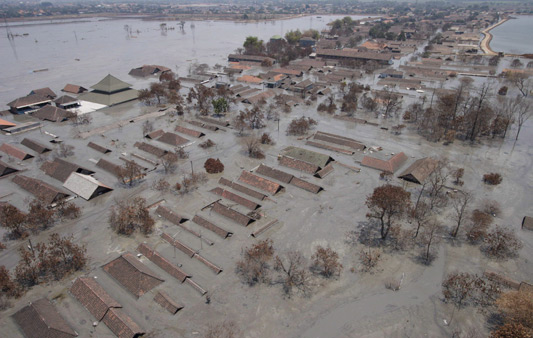Java villagers flee fresh mudflow
Volcanic mud inundates houses after heavy rains cause dam breach in Java.

 |
| More than 15,000 people have been displaced since the mud first erupted in 2006[EPA] |
Villagers on the Indonesian island of Java have had to flee a wave of volcanic mud for the second time in less than two years.
Keep reading
list of 4 itemsTurtles swimming to extinction in Malaysia as male hatchlings feel heat
Could shipping containers be the answer to Ghana’s housing crisis?
Thousands protest against over-tourism in Spain’s Canary Islands
While heavy monsoon rains caused the latest breachr, many residents are blaming man-made activity for creating the danger in the first place.
Residents of Ketapang Keres village in East Java fled their homes in panic as hot, foul smelling mud inundated their houses late last week after the mud volcano breached the barriers built to contain it.
| Indonesia’s mud volcano |
|
At least nine villages evacuated More than 15,000 people displaced Mud 20 meters deep in some places Every day, mud enough to fill about 50 Olympic swimming pools added Government estimates losses could reach $5bn |
Railway tracks and a major road near Porong village were partially submerged before the watery mud receded.
Workers struggled to close the gap in the barrier which had been built after relentless mudflows near Indonesia‘s second-largest city, Surabaya, forced more than 15,000 people to flee in 2006.
Since then thousands of homes, schools and factories have been swamped.
Environmentalists say a company called Lapindo that was drilling for gas at the time, started the disaster in 2006.
An investigation found that the company had indeed violated drilling rules, but in December a court cleared Lapindo of any wrongdoing, saying an earthquake that happened two days before the drilling started was to blame.
Minister’s company
Lapindo is partly owned by the family of Aburizal Bakrie, a cabinet minister and businessman whose family last year topped a Forbes’ magazine list of Indonesia’s richest.
The government has tried several schemes to halt the mudflow, including trying to channel the mud to sea and dropping giant concrete balls into the crater, but all attempts have failed.
Engineers built the dams to hold back the sludge, but they were about to overflow even before heavy rains started pounding the area several weeks ago.
 |
| All government attempts to stem the tide of mud have failed |
Ahmad Zulkarnain, a spokesman for the government body managing the mudflow, said they had been unable to reinforce the 5-metre high dam because there has been no agreement on compensation with the owner of the land where the dam is situated.
The government ordered Lapindo to pay $403.6m in compensation to the victims and to cover the damage.
Some victims have accepted compensation but thousands of others still living in makeshift shelters are frustrated and angry.
And those affected last week “will not receive any compensation”, Imam Utomo, the regional governor, said.
The government has run out of ideas and money to stop the tide, and with 50 Olympic-sized swimming pools of fresh mud surfacing every day, no one knows when the flow will end.
